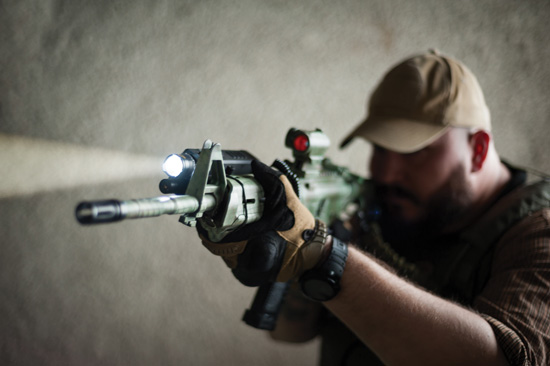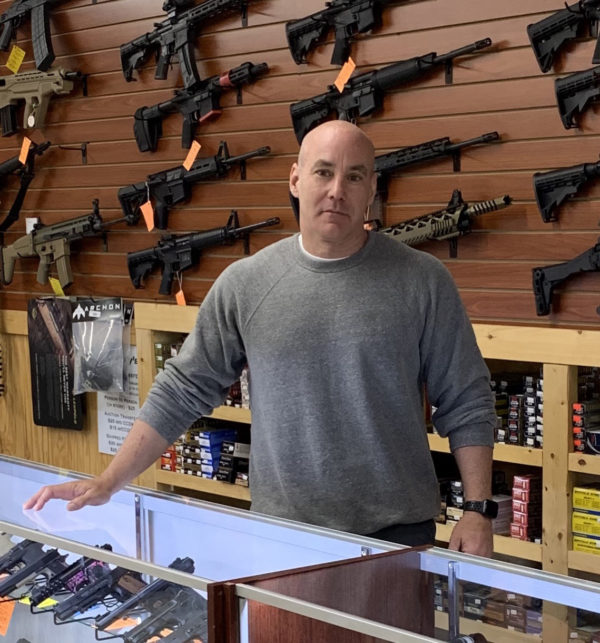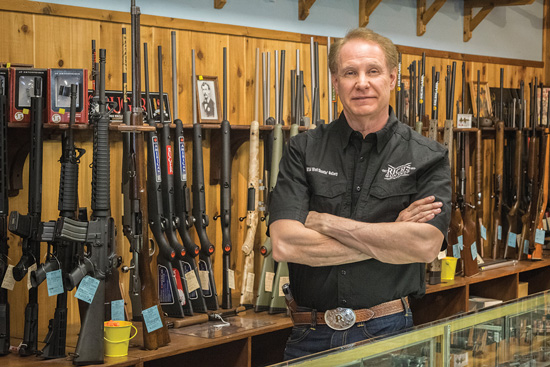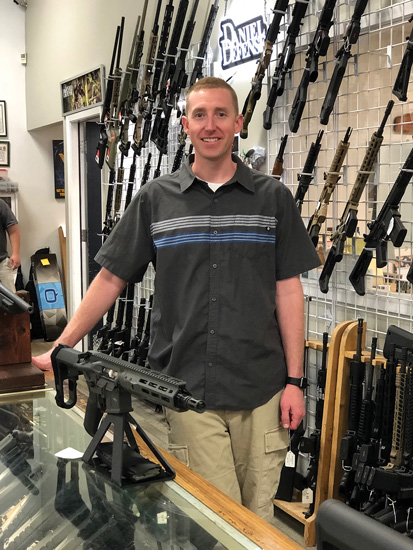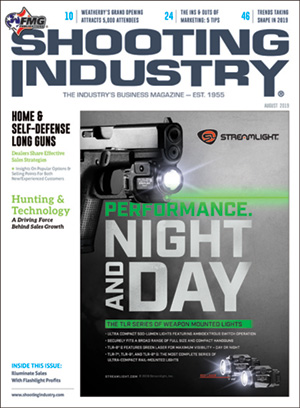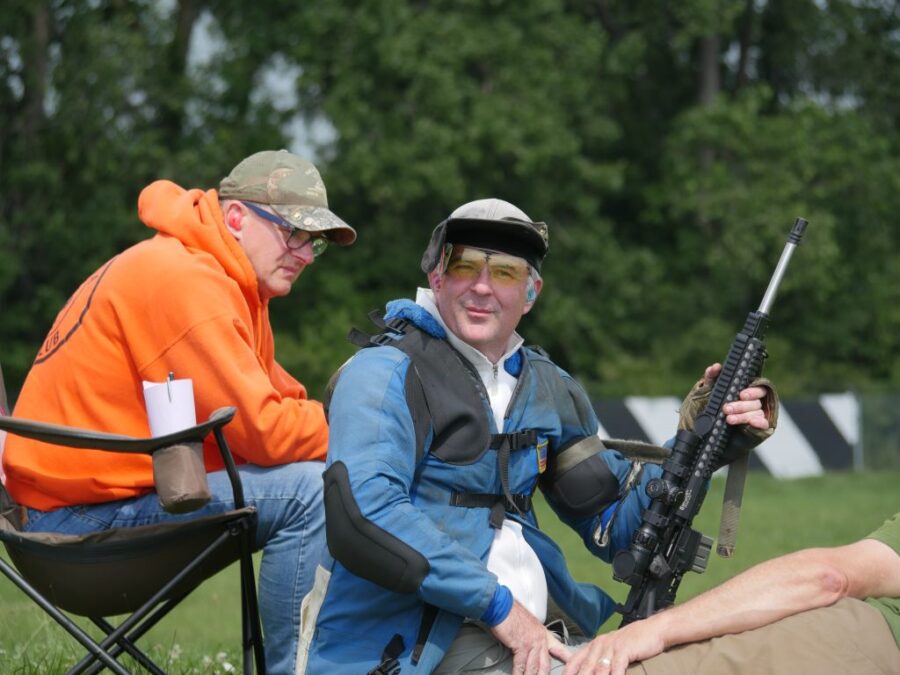Expanding Your Defensive Long-Gun Sales
Three Dealers Share Tactical Insights
Visiting dozens of gun stores across the country over the past few months, I started noticing a couple of consistent trends. The most obvious, and welcome, is the growing number of customers shopping for firearms.
While sales still have not rebounded to what they were under the Obama administration, it’s hard to miss the increasingly crowded aisles in gun stores. The busiest stores I encountered all had at least one thing in common: a healthy offering of the latest rifles and shotguns designed for self-defense and home protection. To find out how retailers are growing their sales with these types of firearms, Shooting Industry spoke with Lee Richeson, owner of Rich’s Gun Shop in Donald, Ore., Neal Bland, owner of Gentry’s Firearms in Harned, Ky. and Jeremy Ball, general manager at Sharp Shooting Indoor Range & Gun Shop in Spokane, Wash. Here are some of the insights and tips these seasoned firearms dealers shared (identified by their initials).
What strategies seem to work best for selling rifles and shotguns designed for self-defense and home protection?
JB: Employee education is extremely important because our consumers are better educated than they have ever been. They have so many resources that if you don’t encourage your employees to learn more about product lines — and use those product lines — then every customer who walks in the door is going to know more than they do. We really encourage our staff to participate in the firearms community through competitive shooting and all the manufacturer points programs and spiff systems out there.
NB: For home defense, one guy who works with me was fairly high-level specialized military, and I’ve got another guy who is a retired state police officer. A lot of what we do when we talk about home defense with long guns is pretty heavily influenced by them and their experiences. The concern I’ve always had over anything in a rifle platform is just the unintended consequences of having to use the weapon in the house because you deal with over-penetration in a way you would not with a handgun. It’s one of the very first conversations we have with people. We actually end up selling a lot of 9mm AR platforms for home defense because of the availability of defensive ammo with limited penetration through drywall. The consequences of making mistakes are a whole lot lower. You still get the manageability and the ease of use in a long-gun platform. For home defense, I’d say we sell an AR 9mm variant probably five- or six-to-one over anything in 5.56/.223.
LR: We listen to people and what they ask for. We don’t try to cram anything down people’s throats because you never know what somebody’s going to want. In our product line, we try to be fairly broad in what we have, so ARs, hunting rifles, hunting shotguns, sporting clay guns and a wide array of handguns of all different sizes and brands. We’re not one of those stores with 480 ARs in stock. We try to spread it around a little bit.
Which brands and models of defensive long guns do your customers prefer?
JB: We sell a lot of mid- and high-end guns. We try to stay away from guns that are often basically at liquidation prices online. We also stay away from devalued products available on the internet, and in big-box retailers.
LR: We stay with the better-quality guns. It’s something I’ve done for forever and ever. We have Smith & Wesson, Ruger, Springfield — all of those higher quality guns from reputable manufacturers. Then we try to handle different colors, some with night sights, some we put lasers on. We seem to do pretty well with everything, but we probably get more calls for home-defense guns here in our area.
NB: This isn’t necessarily all too popular an opinion, but I think some of the stuff coming out of Turkey is as good as anything on the market right now. We sell quite a few TriStars. We sell quite a few Silver Eagles. We’ve had great luck with them. They’ve been really, really good about warranties whenever we’ve needed them. For the price point, you can’t really beat it. They tend to be low enough in price point we can save our margin. In the home-defense market, we sell quite a few Remingtons just because of their identity. The box-fed 870 has been a really good seller. However, I would say with the entry-level shotguns — the Silver Eagles and the TriStars — we probably sell two-to-one over everything else.
Editor’s Note: As revealed in last month’s “U.S. Firearms Industry Today” report, U.S. companies have imported more shotguns from Turkey than any other country over the past two years, importing 237,188 in 2017 and 297,381 in 2018 (a 25.3% year-over-year increase). Turkey had the third-most U.S. imports in 2018.
What recent trends in the market are affecting your sales of defensive long guns?
JB: We have some legislative battles causing issues. Some of Washington State’s changes will require additional steps for people to purchase semi-automatic rifles. It has definitely contributed to some of the success we have had recently in this category.
LR: We have some pretty draconian anti-gun bills working their way through the legislative processes in Oregon. People are concerned. They’re concerned on a nationwide level. Home defense has been on people’s minds for quite a number of years, especially through the Obama years. However, the AR market is very flat for us right now. The laws being passed aren’t so much affecting the ARs as they are locking your guns up and controlling where you can and can’t carry. People are ticked off, and they’re fighting back by buying guns to protect themselves.
NB: This market is so heavily influenced by politics. Every time there’s an incident somewhere, you get big news coverage of all the things that we should do to have more gun control and take this particular weapon off the street because it looks scary. You can just watch the news and hear what comes out politicians’ mouths and think, “It’s going to be an interesting weekend, because we’re going to sell more ARs in the next few days than we’ve sold in 3 months.”
What features in a long gun for self-defense are most important to your customers?
JB: We see an industry trend toward lightweight guns in the market for defensive purposes. People want small, lightweight, shoulder-fired weapon systems. The AR-15-style guns and the AR pistols are a really big market for us right now.
NB: Ease of manipulation would be number one. We stress to people if you ever have to use a gun in a home-defense situation, odds are it’s going to be in the dark at night. The less things you have to move to make this thing work, the better off you’re going to be. Ease of handling and manipulation is the first thing we start talking about, which, honestly, is why we push shotguns so much. From there, it’s about fit, length and weight, and whether or not you want a light on it. We spend a lot of time figuring out what someone’s going to do with it and where they’re going to put it, which influences what they need.
Which types of add-on products help drive sales of self-defense and home-protection long guns?
NB: We do a lot of lights and a lot of reflex sites on defensive long guns. We don’t do a lot of lasers, but we do a lot of lights and a lot of large-window reflex optics — stuff you don’t have to hunt. You put the gun up, you put your cheek on it and it’s right there. Customers don’t have to spend time trying to search for a dot.
LR: Triggers on ARs is a big one. We like Timney triggers. Those are really good. Tactical charging handles with both sides are always good, too.
JB: We don’t find the magnified optic market to be very good at the moment. Red dots, however, continue to become better from a technological and durability standpoint and the price keeps coming down. We’ve found some optics to just be real home runs in the industry recently that are relatively inexpensive. They seem to hold up really, really well — so we’re moving lots of those.
Do you offer classes or training to help secure a sale?
JB: We do, but not for long guns yet. We’re not teaching rifle courses yet. Part of it is the limitation of our indoor shooting range and not being able to shoot rifles inside. But because of some upcoming changes Washington State is experiencing, we’re going to institute a rifle training program, and it’s currently being developed. We think it will absolutely transition to sales. Education is very important in our eyes. In this industry, an educated consumer typically spends more money.
LR: When we know they’re a new shooter, we’ll take them out and introduce them to one of our instructors. We probably have 20 to 25 rental guns — and they help us sell guns. Many times, when a new customer or a new shooter is training, they don’t own a gun. We will draw from our pool of rental guns and hone in on what’s going to work best for them. Probably eight times out of ten, when they’re done with their training, they’re going to buy a gun from us. They usually do. They go in and they rent something, decide they like that one or they don’t like this one, and it helps them make their decision. It’s a big help.
JB: We don’t find the magnified optic market to be very good at the moment. Red dots, however, continue to become better from a technological and durability standpoint and the price keeps coming down. We’ve found some optics to just be real home runs in the industry recently that are relatively inexpensive. They seem to hold up really, really well — so we’re moving lots of those.
Do you notice any differences in what first-time gun owners are attracted to versus more experienced shooters?
LR: Your first-time gun purchasers, most of them are completely clueless. This is why it’s valuable to have a knowledgeable staff of shooters who can recognize what a new shooter or a small-framed person shouldn’t shoot. The guys have been shooting forever, many times they know what they want. They’ve seen it in a magazine or they want to get what their buddy has. They want the latest or greatest, so it doesn’t take a lot of convincing for those guys.
JB: Yes and no. Some first-time gun owners know so much about guns it blows my mind. They have researched stuff till they’re blue in the face. It’s crazy, and really cool they don’t even own a gun yet and they’re so passionate about learning everything. Typically, the experienced gun owners or people who own multiple firearms tend to be brand loyal. They will oftentimes purchase firearms within specific manufacturer lines because of good previous experiences. As a gun salesperson, your job is to deliver the gun, not try to confuse the customer, especially when they know exactly what they’re looking for. One of the biggest detriments to our industry is when you go to a gun store and the sales guy tries to talk you out of buying a gun instead of just giving you exactly what you walked in there for. It’s obviously not good for the customer — or the industry.
NB: Yeah, I think first-time gun owners are more attracted to a look and flash than they are necessarily functionality. They’ll do it because of the cool factor. You may get somebody my age who walks in and looks at it and goes, “Well, it’s pretty, but I don’t need all of that mess. I just need the gun that’s underneath it.”

